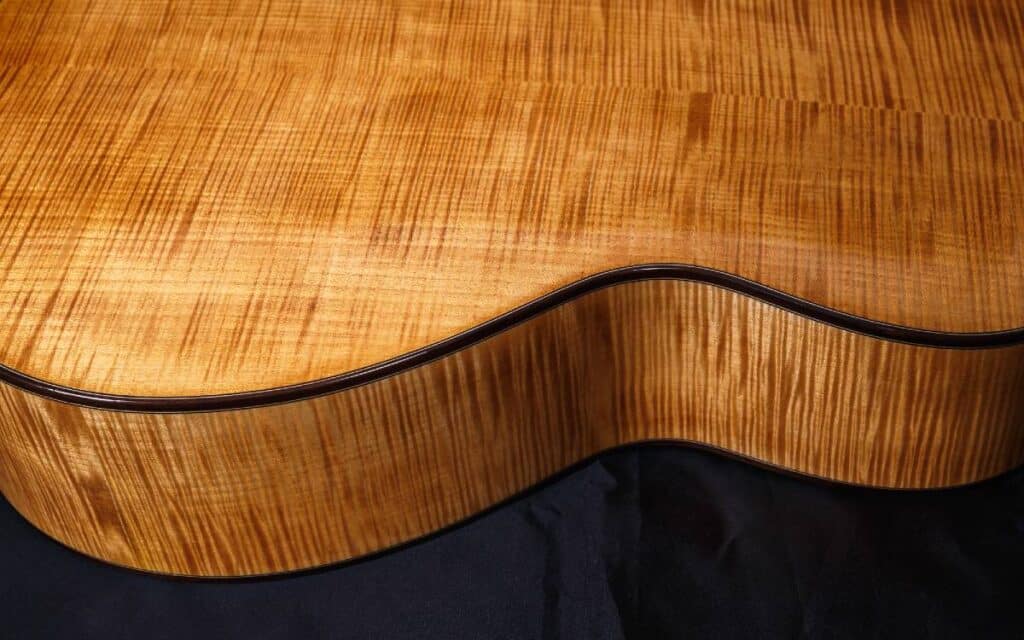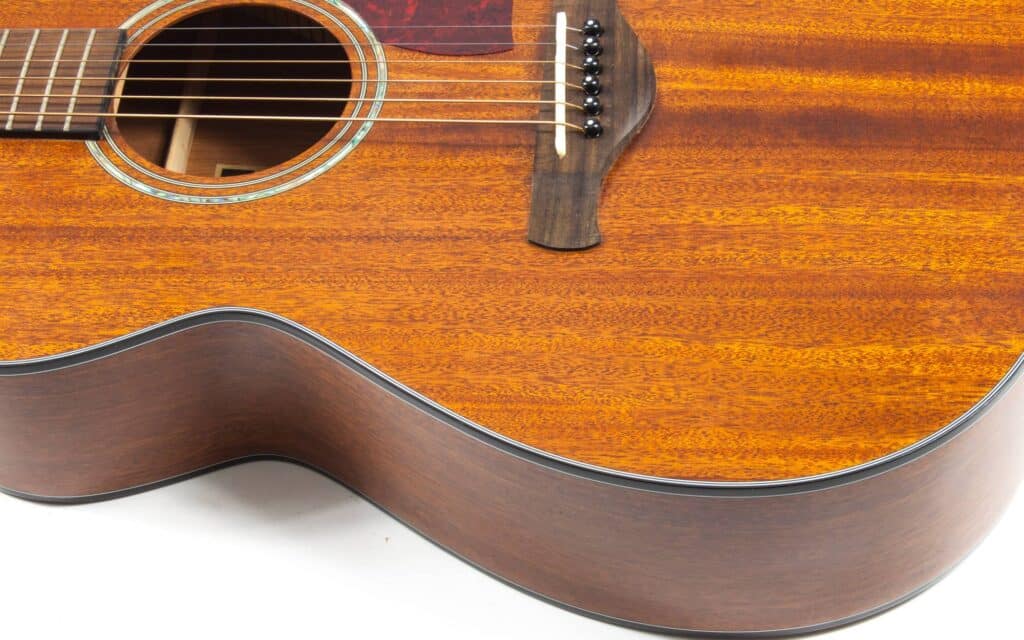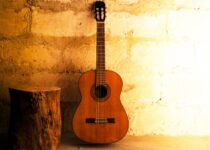The best wood for an acoustic guitar is highly subjective, as it varies from musician to musician. But each tonewood used in the construction of an acoustic guitar has an important influence on its overall sound.
From the top wood to the back, sides, and braces, and even the neck and the fretboard, every wood has a different purpose. The right combination of woods can make or break an instrument.
Guitarists of all skill levels have heard terms like “spruce top” and “ebony neck”. If you’re wondering what they mean, how they relate to your guitar tone, and “What’s the best wood for my acoustic guitar?”, we’ve got you covered.
Tonewood influences more than just your instrument’s aesthetics; it’s critical to the sound of an acoustic guitar. From treble to bass and its overall timbre and resonance, the right choice of woods can be the difference between a $100 practice guitar and a $5,000 work of art. We’ll help you make an informed decision the next time you buy an acoustic guitar.
Post Contents
How Does Wood Affect The Sound Of An Acoustic Guitar?

Acoustic guitars are noticeably simpler than electric guitars in build. Where an electric guitar has a lot of hardware and electronics that can influence its sound, acoustic guitars rely solely on their construction. Take away the hardware of the guitars, and you’re left with an instrument that can sound very different depending upon the structure.
Luthiers use various terms to describe the sound of the guitar they’re making. Other than the size and shape of the body, the main contributor to the musical instrument’s tone is the wood that it’s made out of. Depending upon the wood, your acoustic guitar can sound bright, mellow, rich, warm, or transparent and clear.
When your guitar strings are plucked, they vibrate and cause the air around them to vibrate and amplify the sound. When the air molecules inside the soundboard vibrate at a frequency that matches the frequency of the strings, you have what’s called resonance, which makes the sound louder and more apparent.
The resonant frequencies that your guitar amplifies will change depending upon the construction of your soundboard. This means that depending upon the properties of the wood that your guitar is made of, specific frequencies will be amplified more than others. Hence, your wood will influence your guitar’s overall tone depending upon which frequencies resonate better. Here are some other factors that affect resonance and sound:
Density
The density of the tonewood used to make your guitar can influence both the amplitude (volume) of your guitar, as well as the resonant frequencies.
Denser tonewoods will have less space between respective woodgrains, and thus, they will absorb less of the soundwaves produced by your acoustic. This makes your guitar louder. However, denser woods like rosewood and cocobolo can create greater contrast between frequencies.
Depending on the sound you’re looking for, you could go for a denser tonewood or a lighter wood like cedar or spruce. Cedar and spruce are some of the most common tonewoods used to make acoustic guitars, and when combined with other dense tonewoods, they can create some great-sounding combinations that resonate at melodic frequencies.
Moisture
As a rule of thumb, guitars do not do well with moisture. Relative humidity of 45%-55% is considered ideal for the guitar’s tonewood, which is why you won’t see acoustic guitars being made with very hydrated wood.
Humidity leads to a process called ‘damping’, by which the water absorbs the sound waves produced by the guitar in the wood. A damp acoustic guitar sounds dull and lifeless, and this process will only get more aggravated with time.
With time, humidity can also affect the physical integrity of your guitar, causing structural problems. As you may have figured out, humid wood tends to ‘bend’ more and can cause issues with tuning and hardware. The worst-case scenario would be a damaged, lifeless guitar.
Cedar, spruce, ebony, and rosewood are all harder tonewoods that do not retain much moisture, making them ideal for making guitars. But this also brings to light another important factor – storage. Storing your acoustic in a humidity-controlled environment is essential to keep it sounding fresh and new.
Rare Tonewood And Environmental Problems
It’s no surprise that the choice of tonewood will differ from manufacturer to manufacturer. However, environmental protection laws have recently made importing or exporting rare woods like rosewood and granadillo more challenging (and even illegal in some areas!).
These changes, made by CITES (Convention on International Trade in Endangered Species), were introduced to protect these species from near-extinction. Any guitar using these woods would need CITES certification to move between borders, making the manufacturing process more expensive and cumbersome for luthiers and companies alike.
Acoustic guitars, as a result, have diversified to include more types of wood like ebony and pau ferro. Some of these tonewoods are human-made and try to emulate the sounds of the rarer tonewoods, which are harder to come by.
Solid Wood or Laminated Wood?
Laminated wood guitars have been on the market for a while now as a cheaper alternative to solid wood guitars. They might look similar to the untrained eye, but their sound and usability are entirely different and could make or break your jam session.
Laminated wood guitars use a thin layer of solid wood and paste layer upon layer of cheap plastic material. The result is a guitar whose soundboard looks gorgeous because of the grains from the solid wood top, but doesn’t sound as rich and fulfilling.
Laminated wood often warps and breaks easily because of its compound nature. Since the tonewood in acoustic guitars needs to be thin enough to be malleable, laminated wood seems like a good way to cut costs; this comes at the expense of sound and durability.
Solid wood guitars are noticeably thicker since they’re built with genuine tonewood, often without a smooth grain. The luthier will cut and mirror this sheet of wood, which might be noticeable on some guitars. Therefore, solid wood guitars won’t be as pleasing to the eye as laminated wood guitars.
Watch this video for a better visual understanding of solid vs laminate wood:
Unless you’re in an absolute pinch, we do not suggest picking a laminated wood guitar simply because of their poor payoff. Solid wood is built to last, and it also offers a more resonant tone because of the uniform grain. Laminated wood won’t have that because of its plastic nature.
If you’re on a strict budget, you could choose a good cheap guitar with laminate wood on the back and the sides. We would suggest always choosing a solid top if you can – the top influences the sound of your acoustic the most, and investing in a solid top guitar means investing in a gorgeous tone.
Which Wood Should You Use For Each Part Of Your Guitar?
Contrary to expectations, you don’t need to use the same wood for all your guitar parts. The components of your guitar don’t all perform the same functions, and they don’t contribute equally to sound or tone.
Based on what you want out of the top, neck, or fretboard of your guitar, you could find an acoustic best suited to your needs – or you could go all-out, and custom build a guitar to create the best sound!
The body and the top of your guitar are the most important since they are the main contributors to tone. Whether you want a bassy, rich tone or a mellow and bright sound, your tonewood preference will change.
Lighter woods like ash will give you that transparency and clarity in your sound, with more brightness, while dense, heavy woods like mahogany offer a deep bass with an enhanced body.
The soundboard (or top) timber should be solid and flexible. A bonus is its aesthetic appeal. Several companies like Taylor, Gibson, and Fender use spruce wood for their soundboards since spruce is both resonant and robust.
Most dents and imperfections happen on the guitar’s back, which is coincidentally also the part of the guitar with the most surface area. Strength is not the most significant factor in influencing the wood used to build the guitar’s back, although malleable wood helps when the guitar is being shaped and made.
The back and sides of the guitar often use the same wood. The usual choice is mahogany since the timber reduces overtone while providing enough hardness to make playing sessions comfortable. Rosewood, although rarer, is also a choice if you want to emphasize the lower frequencies and don’t need the level of clarity that mahogany provides.
Tonewood Choices For The Back And Sides Of An Acoustic

The back and sides of the acoustic do a lot more than just provide support to the musician. The body wood used on the back and sides of the guitar determines which frequencies from the soundboard get amplified or dulled down and can influence the overall tonal characteristics of your instrument.
Rosewood
Rosewood is undoubtedly the most commonly sought-after timber to build the back and sides of an acoustic. Coming in two different varieties, their availability is as diverse as how they can change your guitar’s tone.
Brazilian rosewood is the rarer of two varieties since it has been affected significantly by the CITES ban. In comparison, East Indian Rosewood (EIR) is easier to produce, and therefore, cheaper. The main difference in how they look lies in their graining. EIR has straighter graining than Brazilian rosewood, though both sport similar chocolate-brown coloring.
Both varieties of rosewood offer a clear and bright sound without taking away any of the resonant frequencies. It adds a distinctly rich overtone and a metallic twinge to the guitar tone, making it hard to replicate with other woods. You’ll find them commonly used on classic Fender guitars.
Sapele
Sapele is a close relative of mahogany hailing from Africa. The beauty of this tonewood, other than the layers of its sound, lies in the fact that the wood is sourced sustainably to prevent over-harvesting.
Sapele tends to be a light reddish or amber shade compared to mahogany, even though they both sport similar graining. The wood provides low and mid-range amplification with adequate coloring on the top end. This makes Sapele perfect for various styles, including strumming, fingerpicking, and everything in between.
Mahogany
The classic mahogany back guitar has been a staple from Gibson and Taylor since the pre-war eras. It is a stiff, hard, and dense tonewood and has a distinctly mellow and warm tone. Mahogany guitars are known for their punchy and balanced sound with a relatively loud midrange which is hard to find in other tonewoods.
Matured mahogany creates a more pronounced fundamental tone, providing richer overtones. This means that the quality of sound produced by mahogany guitars will change over time, making them an actual investment for any guitarist.
Mahogany guitars and their characteristic sound can be heard in many older recordings to this day and have become a cornerstone in blues and roots music. It provides a punchier and darker tone than rosewood while also keeping the midrange intact. If you want a warm, rich-sounding guitar, then mahogany is a fantastic choice.
Tonewood Choices For The Guitar Top

The wood used in your acoustic top is easily the most influential in the overall tone of your guitar. Not only is it the first part of the guitar that everyone notices, but it is also the main contributor to the instrument’s sound. Understanding which timber plays best to your style is imperative to making the best choice for buying a guitar.
Spruce
Spruce wood is the industry standard for acoustic guitar tops, bar none. Most steel-string acoustics feature a spruce top, either solid or laminated. Several species are used in making spruce tonewood, including Sitka, Engelmann, and Adirondack. In general, it’s a very light-coloured wood.
Sitka spruce is the most common, but it also tends to be one of the higher-priced tonewoods out there. Sitka has a tight and straight grain that adds clarity to the guitar’s tone and enables more overtones in the sound. The quality of sound will also depend on how well your Sitka spruce top was cut and braced.
Engelmann spruce is a close relative of Sitka, although it tends to have more visible growth rings and can generally be identified by its coloring. It will usually sport cream or white “stripes” that run horizontally in the wood grain and produce sound with slightly less clarity than Sitka. This makes Engelmann perfect if you prefer a more rounded tone.
Adirondack spruce is the rarest of the three main species, and it shows. The tightest grain of any Sitka spruce, Adirondack tends to be darker in color with less visible stripes. It generates a warmer tone that has excellent clarity and pronounced projection.
Spruce works great across a broad dynamic range and suits just about any playing style. You’re sure to get consistent sound with little harmonic complexity. This does not mean that spruce guitars lack character, though. The species of spruce used to make acoustics do different jobs – Engelmann sounds lighter and has less projection, and Adirondack makes a louder guitar. So you can pick the one that suits you.
You can recognize a spruce-top guitar by its white or pinkish color. Interestingly, all spruce guitars tend to tan over the years and become yellower. There’s no lack of versatility or character in these guitars, and that makes them an industry favorite.
Cedar
The second most used tonewood for guitar tops after spruce, cedar is traditionally used in classical guitars. That doesn’t mean that the wood doesn’t hold up well in steel-string guitars, though.
Cedar is less dense than spruce, giving it a darker tone and emphasizing bass frequencies. It produces richer overtones, giving your guitar less brightness but more character. The sound from a cedar guitar is characteristically lush and less projected.
If you’re someone who strums their guitar, cedar might not be the best option for you, although it will suit fingerpicking guitarists perfectly. They don’t provide the kind of attack that strummers need, but their clean tone is ideal for picking. Their use in classical guitars is for that reason – their characteristic nuance while playing soulful melodies.
Red cedar from North America has a honeyed-amber color that does not change over time. The straight graining looks gorgeous on soundboards, which is always a bonus when paired with their impeccable sound.
Here’s a quick video comparison between cedar and spruce:
Koa
Despite being used mainly in ukuleles, Koa is surprisingly suited to guitar tops as well. It is a pricier wood, however, since it is less common. This Hawaiian wood sounds beautifully bright and punchy and changes sound as it ages.
An aged Koa guitar will sound richer and warmer, emphasizing mid-range tones. This makes it ideally suited for fingerpicking styles. The bass response for Koa is a little less than rosewood, and its crispness shines through in the upper ranges.
A Koa guitar is easily recognizable by the dark brown wood with blonde streaks. There isn’t much change in the appearance of the wood as it matures, but the difference in sound more than makes up for it. If you’re a fingerstyle player, then Koa may suit you very well.
Maple
Another popular tonewood for acoustic guitar tops, maple has a very bright sound that projects well. It is a dense wood that gives guitars a long sustain and lots of clarity.
Maple is often used in electric guitars for the neck and fretboard due to its smooth surface, but it also makes an excellent acoustic top.
A maple guitar will have a hard attack and a quick decay. It’s not the kind of wood that produces a lot of bass, but it does sound great with fingerpicking styles. The tone is bright and brilliant, perfect for lighter genres that require distinct articulation.
Maple tops have cream or white color, with tight grains that can produce some stunning figuring. Over time, the wood may darken to a light brown. Straight-grained maple will likely produce more overtones than highly figured varieties.
Maple is the soundboard material of choice for many jazz guitarists thanks to its warm, mellow tone. If you prefer a balanced, even tone without too much low end, this might be the wood for you.
Walnut
Walnut is another dense tonewood that has a lot of low end and a moderate amount of highs. It projects well and gives guitars a warm tone that is great for blues or country music.
Walnut has a coarse texture that can be difficult to work with, but the results are worth it. The soundboard will have an excellent bass response and plenty of sustain. A walnut guitar top will change color over time, darkening to a deep brown.
What About The Neck And The Fretboard?

Historically, guitar necks have always been made of either maple or mahogany. Both of these woods are easy to work with and do not get too stressed under tension, which is something you cannot compromise on when you’re building a guitar neck.
Since guitar necks themselves don’t contribute much to the actual sound, the focus here is durability, stability, and smoothness for the left hand to allow maximum playability.
The guitar fretboard has a broader array of woods since this is one of the main parts of the instrument that you’re in contact with when playing. When considering fretboard tonewood, you should consider feel and playability above all.
Ebony
Ebony has been a stable choice of wood for fretboards over the years. Even though it is more commonly seen on an electric guitar, the instantly recognizable dark timber also works wonders with an acoustic. Both African and Asian ebony is used to build fretboards, even though African ebony is more common because of its even color.
The iconic ebony fretboard is dense and heavy but smooth because of its high natural oil content. The naturally smooth feel allows most players to play fast, especially in styles involving a lot of fretwork, such as lead and picking.
Ebony fretboards hold up to years of playing and are very wear-resistant. Its density makes it the ideal tonewood for fretboards, providing a bright attack with prolonged sustain.
They also combine well with stainless steel frets, as the harder fret material does not wear down the heavy wood. This makes the frets last even longer, so there’ll be less re-fretting over time.
Micarta
Although technically not a type of tonewood, micarta is becoming more popular by the day as a cheaper alternative. Micarta, a brand name, is an amalgamation of materials that are bonded by resins.
The nature of Micarta makes it strong and durable, making it perfect for fretboard use. As for aesthetic benefits, Micarta is nearly indistinguishable from ebony, so if you’re going for the look of timbre with a smoother finish, Micarta is your best friend.
Since Micarta is structurally different from wood and is an inorganic material, it will not change over the years. This means that you won’t have to set up your strings or tune your guitar more frequently as the weather changes since the fretboard will hold its shape perfectly.
But some players may not like its feel, so it’s a good idea to test a Micarta fretboard at your local guitar store so you can see if it suits your playing style.
Rosewood
Rosewood isn’t just for backs and sides – it’s ideal for fretboards too. It would have retained its spot as the most favored tonewood for fretboards if not for the CITES restrictions. Indian rosewood is more common even in fretboards since Brazilian rosewood has had heavy restrictions placed on its trade.
The popularity of rosewood for fretboards is all thanks to its smooth feel and its durability. The wood does not stain or wear out quickly and can take sharp attacks with ease. The smoothness of rosewood and its organic nature allows the fretboard to absorb your finger’s natural oils, making it smoother and more responsive to movement as it ages.
The sound from a rosewood fretboard is distinctly warm with rich overtones. Unlike ebony, however, rosewood is more prone to drying if not played regularly and thus needs a little more maintenance to keep it in its best condition.
Then, Are All Good Guitars Made Of Tonewood?
Not at all! You can get great guitars that aren’t made of tonewood.
One of the most innovative guitars made in the 20th century is the resonator guitar. Resonators use a spun aluminum cone to turn the player’s picking energy into music much louder than an acoustic guitar can make.
As guitars moved from parlors in houses to live audiences, the instrument needed to be louder to reach more people. A Slovak-born luthier named John Dopyera created the resonator in the 1920s, using the same mechanism of amplification used in our home stereos nowadays.
The resonator guitar contains three thin aluminum cones inside the soundbox, which face the back of the guitar. As the musician strums, these cones pick up on the vibration of the air molecules and amplify them several times over, making the resonator loud enough without needing extra electrical power (like an electric guitar)!
Resonators sound almost liquid, with complex overtones and tons of reverb. Despite having a very niche market in the acoustic guitar world, some companies like Dobro and National specialize in making only resonator guitars. This makes resonators incredibly nimble and tailored to specific musicians’ needs.
Besides resonators, you also have modern acoustic guitars made of synthetic materials like carbon fiber. Some manufacturers like Blackbird are using artificial composites as well. So the options beyond wood are only increasing as technology develops!
Finally, What Is The Best Wood For Acoustic Guitars?

There is no one answer to that question. Every player will have a different answer to that question because, ultimately, it all boils down to individual preference. Acoustic guitar construction has evolved a lot over the years, but the essentials are timeless.
Depending upon your style, budget, and expertise, your choice of wood will change. A lower budget will quickly limit the tonewoods that are available to you since anything rare or uncommon will become pricier than you expect.
An amateur or beginner would do well with a spruce top and an ebony fretboard since both are relatively neutral in tone. In contrast, a professional guitarist would prefer tonewoods best suited to their playing style.
Guitarists who find themselves drawn more to a specific manufacturer will often find themselves unsatisfied with guitars from another manufacturer, even if they use the same tonewood to build them. Different companies source their raw material differently, and wood, being an organic material, will never be the same across the board.
It helps to picture the different tonewoods as the tools in your shed. One wouldn’t necessarily say that the pliers are better than a chainsaw, just that they perform different functions. Beginners will need just a hammer and screwdriver – in this case, a spruce-top ebony-neck – and as your experience grows, you can keep adding more tools to your arsenal!
Regardless of where you are in your guitar journey, it always helps to know the basics of what tonewoods are and how they make your guitar sound. It will help you make an informed final decision and experience the most out of your instrument. And if you decide to build a custom guitar, you’ll be able to pick the right components for your dream guitar!
Frequently Asked Questions About Acoustic Guitar Tonewoods
Which wood is bad for guitars?
There is no objectively bad wood when it comes to guitars and tonewood since personal preference is a significant factor when people decide which wood they like. However, laminate guitars tend to have a worse payoff than solid wood guitars.
Despite being cheaper than solid wood guitars, laminate guitars don’t have the character or unique tone that solid wood guitars have. They are also less durable and more prone to damage from humidity, considerably dampening the overall experience of playing them.
But the only wood that’s bad for guitar is the wood that doesn’t sound right to you. As long as you’re satisfied with a certain tone, you can enjoy playing your favorite music.
How do you tell if a guitar is made from solid wood or laminate?
Both solid wood and laminate guitars could look very similar, and the difference in sound is difficult for beginners and amateurs to pick up on.
Visually, check for cross-sections of the top wood. You might find this visible near the soundhole of your guitar. If the cross-section of wood there is covered by an insert, that’s a dead giveaway for a laminate top guitar.
Solid top guitars have a cross-section that shows the grains of the wood, sort of like a horizontal ladder. A laminate top guitar will not have these distinct patterns. This should let you know the difference easily.
What kind of finish should I use on an acoustic guitar?
The kind of finish you should use on an acoustic guitar depends on the wood being used, primarily the top wood. Nitrocellulose lacquer is one of the most common finishes that’s safe and compatible with most woods, but you can also go for water-based or oil-based varnishes.
Some players prefer the raw look of their guitars, especially with classical instruments. You can also choose between matte and gloss depending on your preference, but consult a guitar technician if you’re thinking of refinishing your old acoustic.







